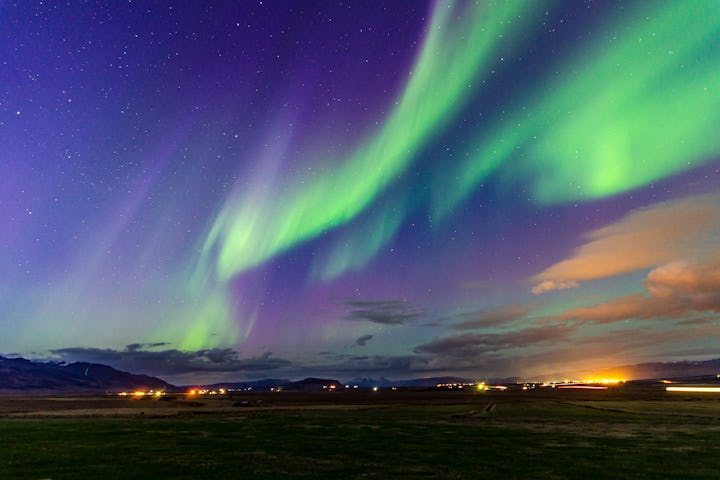Your Best Shot At Seeing The Northern Lights In The US Starts Right Now
This week, people in at least 17 states will be able to see the northern lights. Don’t miss out.

Just in time for the warmer weather, the northern lights are coming to the sky near you. The incredible sky show is typically only rarely seen in the lower 48 states of the United States, with most of the activity visible aurora further north, like in Alaska, Scandinavia, and northern Canada.
But all the signs are aligning to allow more of us to bask in the natural beauty, so you might want to plan a campout in the yard or let your kids stay up late. Here’s what you need to know to catch the spectacular northern lights with the kids.
What are the northern lights?
The northern lights stem from the sun, which is 152.09 million kilometers away, according to Canadian Space Agency. The Sun is always releasing particles into space, and those particles carry electrically charged protons and electrons in what’s called solar wind.
When that solar wind reaches the magnetic field of Earth, specifically the north pole where the magnetic field is weaker, the particles enter our atmosphere, causing a reaction of energy called a geomagnetic storm, which causes the northern lights, or the aurora borealis.
Why will the northern lights be so visible in the United States this week?
While the northern lights are most often only seen far north, sometimes the light show travels further south into the lower 48 states of the United States, thanks to the Sun’s magnetic field and the Sun’s solar cycle.
“Every 11 years or so, the Sun’s magnetic field completely flips,” NASA explains, which is called the solar cycle. “This means that the Sun’s north and south poles switch places. When those poles switch, so does the Sun’s surface activity, meaning there is stronger solar wind resulting in stronger geomagnetic storms on Earth.”
Currently, we’re about halfway through Solar Cycle 25, according to the National Oceanic and Atmospheric Administration. This cycle will peak in 2025, which means we’re in the zone where the solar wind will be at its highest. And since this will result in stronger geomagnetic storms that will push the lights further south into 17 states this week.
Which states could see the northern lights this week?
According to Earth.com, the states that may be able to see the northern lights this week include:
- Alaska
- Montana
- North Dakota
- South Dakota
- Minnesota
- Wisconsin
- Michigan
- Maine
- Maryland
- New York
- New Hampshire
- Washington
- Vermont
- Idaho
- Massachusetts
- Wyoming
- Indiana
When will the northern lights be visible in the United States?
The Space Weather Prediction Center says the best time to watch the northern lights is between 10 p.m. and 2 a.m. local time on Thursday, July 13.
“These hours of active aurora expand towards evening and morning as the level of geomagnetic activity increases,” the center explains. “There may be aurora in the evening and morning, but it is usually not as active and, therefore, not as visually appealing.”
How to watch the northern lights with the kids
If the summer weather is going to be nice where you are, it’s the ideal time to keep an eye on the sky to see if you can catch the northern lights. The Space Weather Prediction Center says you won’t need any special equipment to see the auroras, but there are a few things you can do to make it a comfortable setup to watch.
The center says you’ll want to choose a spot where there is very little light pollution, so get outside any big cities, if possible. Also, the highest elevation safely possible will allow you to see more of the light show as well. Hopefully, the weather will cooperate because having skies that aren’t too cloud-covered will allow you and the kids to have a better viewing.
To find the northern lights in the sky, it might be best to lay a blanket on the ground and scan the skies from there on your back. Or comfortable lawn or camping chairs will work, too. The northern lights often appear from all directions, so scan the sky and enjoy the view.
If you don’t live in one of the 17 states, you can catch the show on a livestream.
If you’re not one of the lucky ones who live in the 17 states that have a good chance to see the lights from your home, there is no need to stress. You and the kids can watch the lights from the comfort of your home.
Explore.org, the world's leading philanthropic live nature cam network, has a camera set up to catch the aurora borealis.